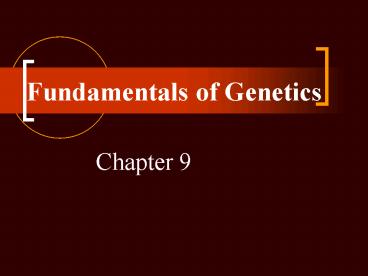Fundamentals of Genetics - PowerPoint PPT Presentation
1 / 20
Title:
Fundamentals of Genetics
Description:
... by genes, which are found on chromosomes. Genetics The study of heredity ... The 'Father of Genetics' Austrian monk in charge of the gardens at the monastery ... – PowerPoint PPT presentation
Number of Views:468
Avg rating:3.0/5.0
Title: Fundamentals of Genetics
1
Fundamentals of Genetics
- Chapter 9
2
Heredity
- The passing of traits from parents to offspring
- Traits are characteristics like hair color, pea
plant height, the ability to roll your tongue,
blood type - Traits are controlled by genes, which are found
on chromosomes - GeneticsThe study of heredity
3
Gregor Mendel
- The Father of Genetics
- Austrian monk in charge of the gardens at the
monastery - He was interested in pea plants
4
Gregor Mendel cont.
- Specifically, why did the plants have different
traits? - For example--why did some have green seeds and
some have yellow seeds - He experimented with the plants. His accidental
choice of pea plants served as the foundation for
future genetic studies
5
Pea Plant Traits
6
Why was Mendel Successful with the Peas?
- Easy to control their pollination
- He used pure-breeding, contrasting varieties
- Pure/True Breedingif allowed to self fertilize,
will only produce offspring exactly like them - Studied one characteristic at time for many
generations - Used statistics to analyze his results
- Obtained large number of offspring
7
Gregor Mendel cont.
- So what exactly did Mendel do? Very basically,
he mated different plants together, counted the
types of offspring produced, and then looked for
patterns.
8
Mendels Experiment
- First he crossed (mated) a true breeding round
seed with a true breeding wrinkle seed plant - This was his parental (P) generation)
9
Mendels Experiment cont
- All the offspring in his first generation (F1)
were - ROUND
- He was surprised because the wrinkled trait
seemed to have disappeared in the F1 offspring
10
Mendels Experiment cont
- Next he allowed an F1 offspring to fertilize
itself - Round X Round
- The resulting
- offspring were
- ¾ round
- ¼ wrinkled
- This is the F2 gen.
11
Mendels Experiment cont
- He was surprised again, the wrinkled trait hadnt
disappear, it must have been hidden - Hidden in the F1 plant
- It then reappeared in some of the F2 plants
- Mendel repeated the experiment for other traits
- Seed color, flower position, plant height
12
Mendels Conclusions
- Each organism has two genes controlling each
trait. One gene comes from the mother, the other
comes from the father
13
Terminology
- Dominantone gene in a pair that prevents the
other gene from being expressed/shown - A dominant gene is a printed, capital letter
- Recessivegene that is hidden by the dominant
gene - A recessive gene is a cursive, lower case letter
14
Terminology cont.
- Homozygoustwo genes in the pair are identical
(aka purebred) - ExamplesTT or tt
- Heterozygoustwo genes in a pair are different
(aka hybrid) - ExampleTt
15
Terminology cont.
- GenotypeThe genetic makeup of an organism
- Examples TT, Tt or tt
- PhenotypeThe physical appearance of an organism
- Tall, short, purple
16
Terminology cont.
- Alleledifferent choices of phenotype for a
gene - Your trait could be hair color and your alleles
could be beige, blonde, brown, black and red
17
Law of Segregation
- Remember that genes occur in pairs
- Each gamete receives only one allele of each pair
(in other words, the alleles segregate) - So if you have Aa 50 of the eggs will receive
the A and the other 50 will receive the a
18
Law of Segregation cont.
- If you have an organism with H H
- 50 will get H
- 50 will get H
- Or 100 of the eggs/sperm will get an H
19
Law of Independent Assortment
- Another law belonging to Mendel
- Will be addressed at another time
20
So Lets Go Back to Mendels Experiment
RR
rr
hybrids
Rr
Rr
rr
RR
Rr
rR































